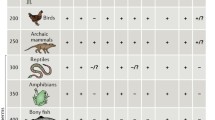Abstract
This study describes the ontogeny of allograft immunity in a partially inbred strain of frogs (Xenopus laevis). At various times during the frogs' premetamorphic, perimetamorphic, and postmetamorphic life, major histocompatibility complex (MHC) homozygous strain JJ Xenopus (MHC haplotype j) were grafted with skin from adult donors of defined MHC homozygous (j,f) and heterozygous (j/f f/h) haplotypes. This protocol reveals that destructive allograft reactivity to MHC alloantigens in Xenopus matures slowly and that allotolerance can be induced to such MHC-encoded antigens throughout larval life. The ultimate fate of an MHC disparate transplant (survival or rejection) is dependent on several interacting variables, which include antigen dose, haplotype dose, and the developmental stage of the host frog at the time of transplantation. In contrast, minor H-locus disparate (MHC compatible) grafts never appear to be rejected by hosts grafted at any larval stage.
Similar content being viewed by others
References
Barlow, E. H.: “Thymus dependency and in vitro correlates of perimetamorphic tolerance in Xenopus laevis”. Ph. D. thesis, University of Rochester, Rochester, New York 1980
Barlow, E. H., DiMarzo, S. J., and Cohen, N.: Prolonged survival of the disparate skin allografts transplanted to the metamorphosing frog, Xenopus laevis. Transplantation 32: 51–57, 1981
Benacerraf, B. and Unanue, E. R.: Textbook of Immunology, pp. 166–177, The Williams and Wilkins Company, Baltimore 1979
Bernardini, N., Chardonnens, X., and Simon, D.: Tolérance aux allogreffes cutanées chez Xenopus laevis. Influence de la taille et de lâge du greffon. C. R. Acad. Sci. Paris. 270: 2351–2354, 1970
Billingham, R. E.: The passenger cell concept in transplantation immunology. Cell. Immunol. 2: 1–21, 1971
Chardonnens, X.: Tissue typing by skin grafting during metamorphosis of the toad Xenopus laevis Daudin. Experientia 31: 237, 1975
Chardonnens, X. and Du Pasquier, L.: Induction of skin allograft tolerance during metamorphosis of the toad Xenopus laevis: a possible model for studying generation of self tolerance to histocompatibility antigens. Eur. J. Immunol. 3: 569–573, 1973
DiMarzo, S. J.: Ontogeny of alloreactivity in the toad, Xenopus laevis. Ph.D. thesis, University of Rochester, Rochester, New York, 1980
DiMarzo, S. J. and Cohen, N.: An in vivo study of the ontogeny of alloreactivity in the frog, Xenopus laevis. Immunology 45: 39–48, 1982
Du Pasquier, L. and Bernard, C. C. A.: Active suppression of the allogeneic histocompatibility reactions during the metamorphosis of the clawed toad Xenopus. Differentiation 16: 1–7, 1980
Du Pasquier, L. and Chardonnens, X.: Genetic aspects of the tolerance to allografts induced at metamorphosis in the toad Xenopus laevis. Immunogenetics 2: 431–440, 1975
Du Pasquier, L., Chardonnens, X., and Miggiano, V. C.: A major histocompatibility complex in the toad Xenopus laevis (Daudin). Immunogenetics 1: 482–494, 1975
Du Pasquier, L. and Wabl, M.: Amphibian models for the study of the ontogeny of immunity. In A. Cunningham (ed.): Generation of Antibody Diversity: A New Look, pp. 151–173, Academic Press, New York, 1976
Galion, M.: Factors involved in the rejection of skin transplanted across a weak histocompatibility barrier: Gene dosage, sex of recipient, and nature of expression of histocompatibility genes. Transplantation 5: 154–168, 1967
Hašek, M. and Chutná, J.: Complexity of the state of immunological tolerance. Immunol. Rev. 46: 3–26, 1979
Hildemann, W. H.: Components and concepts of antigenic strength. Transplant. Rev. 3: 5–21, 1970
Hildemann, W. H., Clark E. A., and Raison, R. L.: Comprehensive Immunogenetics, Elsevier/North Holland Publishing Co., Amsterdam, 1981
Hildemann, W. H. and Cohen, N.: Weak histoincompatibilities: Emerging immunogenctic rules and generalizations. In E. S. Curtoni, P. L. Mattiuz, and R. M. Tosi (eds.): Histocompatibility Testing, pp. 13–20, Williams and Wilkins Co., Baltimore, 1967
Hildemann, W. H., Morgan, M., and Framnick, L.: Immunogenetic components of weaker histoincompatibility systems in mice. Transplant. Proc. 2: 24–31, 1970
Holáň, V., Chutná, J., and Hašek, M.: Specific suppression of antigen-reactive cells in neonatal transplantation tolerance. Nature 274: 895–897, 1978
Katagiri, C.: Xenopus laevis as a model for the study of immunology. Dev. Comp. Immunol. 2: 5–14, 1978
Kobel, H. R. and Du Pasquier, L.: Strains and species of Xenopus for immunological research, In. J. B. Solomon and J. D. Horton (eds.): Developmental Immunobiology, pp. 299–306, Elsevier/North Holland Biomedical Press, Amsterdam, 1977
Lapp, W. S. and Bliss, J. Q.: The effects of allelic dosage and graft size on skin graft survival across a weak histocompatibility barrier. Immunology 12: 103–109, 1967
Lapp, W. S. and Bliss, J. Q.: Significance of allelic dosage and graft size on tolerance induction by H-1-incompatible skin grafts. Transplantation 10: 389–395, 1970
Litchfield, J. T., Jr.: A method for rapid graphic solution of time-percent effect curves. J. Pharmacol. Exp. Ther. 97: 399–408, 1949
Manning, M. J. and Horton, J. D.: Histogenesis of lymphoid organs in larvae of the South African clawed toad, Xenopus laevis (Daudin). J. Embryol. Exp. Morphol. 22: 265–277, 1969
McKhann, C. F.: Transplantation studies of strong and weak histocompatibility barriers in mice. II. Tolerance. Transplantation 2: 620–626, 1964
Nieuwkoop, P. D. and Faber, J.: Normal Table of Xenopus laevis (Daudin), p. 1–252, North Holland, Amsterdam, 1967
Snell, G. D., Dausset, J., and Nathenson, S.: Histocompatibility, pp. 357–389, 1976
Tochiani, S. and Katagiri, C.: Complete abrogation of immune response to skin allografts and rabbit erythrocytes in the early thymectomized Xenopus. Development, Growth, and Differentiation 17: 383–394, 1975
Williams, G. M., Krajewski, C. A., Dagher, F. J., Haar, A. M. ter, Roth, J. A., and Santos, G. W.: Host repopulation of endothelium. Transplant. Proc. 3: 869–872, 1971
Author information
Authors and Affiliations
Rights and permissions
About this article
Cite this article
DiMarzo, S.J., Cohen, N. Immunogenetic aspects of in vivo allotolerance induction during the ontogeny of Xenopus laevis . Immunogenetics 16, 103–116 (1982). https://doi.org/10.1007/BF00364398
Received:
Revised:
Issue Date:
DOI: https://doi.org/10.1007/BF00364398




